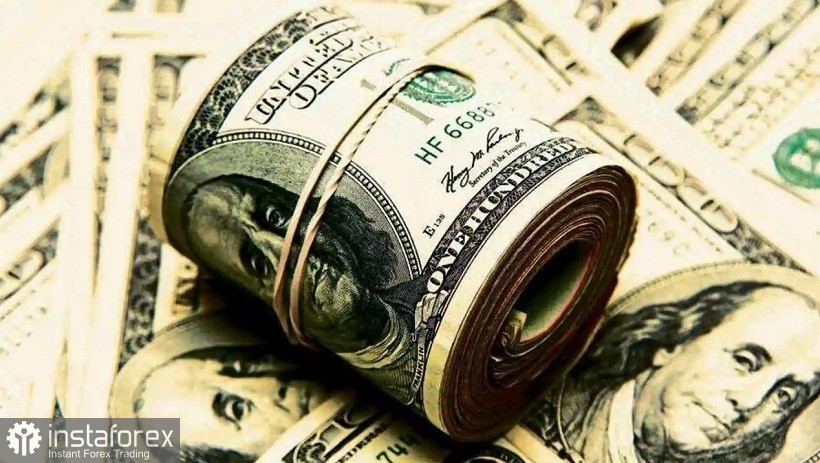The EUR/USD pair continues to fly down, amid the strengthening of the safe dollar and the weakening of the euro. Last week, bulls managed to update the multi-week high (1.1185), but could not keep the occupied height. Given the bearish onslaught, at the moment there is a risk of a price "stall" not only to the base of the 9th figure, but also to the support level of 1.0860. The strengthening of anti-risk sentiment, the hawkish attitude of the Federal Reserve, the growth of inflation in the United States and the decline in American unemployment - all these fundamental factors allow dollar bulls to feel quite confident. Especially when paired with the euro, which is under pressure from various problems (European Central Bank indecision, geopolitical instability in Eastern Europe, the "gas issue").
The dollar turned the situation in its favor at the end of last week, when the Nonfarm data were published. The unemployment rate in the United States fell to 3.6%, while the average hourly wage increased by 5.6% year-on-year. These figures only complemented a fairly unambiguous picture of a fundamental nature. Earlier, the index of personal consumption expenditures was published, which updated a long-term (since 1983) record, as well as the consumer price index, which accelerated to 7.5% yoy - this is the highest value of the indicator over the past 40 years. And core inflation "did not disappoint": the core index jumped to a 6 percent mark year-on-year.

The jump in inflation against the background of falling unemployment allowed many representatives of the Fed to tighten their rhetoric. Over the past two weeks, several members of the Fed have announced that the interest rate at the May meeting could be increased by 50 basis points at once. In favor of such a scenario, in particular, the head of the Federal Reserve Bank of San Francisco, Mary Daly, spoke out. According to her, such an adjustment of the rate "will be appropriate." Earlier, a similar position was voiced by other colleagues of Daly – for example, Evans, Bullard, Barkin, Mester, Brainard, Williams (albeit indirectly) and Waller. And Fed Chairman Jerome Powell recently made it clear that he is ready for tougher measures to prevent the consolidation of high inflation. The strengthening of the hawkish mood among the Fed members was also recorded by the currency strategists of Goldman Sachs. In their opinion, the Fed will raise the interest rate more aggressively in the near future. They believe that the central bank will decide on a 50-point increase not only in May, but also in June.
Thus, the Fed acts as a fairly powerful ally of the US currency. However, the greenback strengthens its position not only by strengthening hawkish expectations. Geopolitics is in the foreground. On the one hand, the information flow is bubbling here: many experts, political scientists, journalists voice their thoughts on the development of the current situation. But on the other hand, traders clearly lack "crystallized" first-hand information, that is, from representatives of negotiating groups. At the moment, an information vacuum has formed again around the negotiation process between Russia and Ukraine – it is only known that the dialogue continues in the video format. Yesterday, Russian Foreign Minister Sergei Lavrov said that there are "chances of success" in the negotiations. However, he did not comment on the negotiation process in detail, so his rhetoric did not reverse the downward trend of EUR/USD. The dollar continues to be in demand as a protective asset.
Meanwhile, the European currency is under pressure. The record increase in inflation did not help the euro: according to most experts, the latest release on the growth of the consumer price index in the eurozone will not change the ECB's position on rates. After this release, ECB President Christine Lagarde said that food and energy prices in the eurozone "most likely" will stop growing. In her opinion, this should help Europe avoid stagflation. At the same time, some representatives of the ECB (Holzmann, Vasle) allowed the option of raising the interest rate at the end of this year. But most of their colleagues prefer to voice more cautious rhetoric, touching only on the prospects of QE and "bypassing" the topic of rates. Therefore, traders actually ignored the latest inflation report, not counting on the tightening of monetary policy by the ECB.
The energy crisis is also putting pressure on the euro. On Friday, the exchange price of gas in Europe increased by more than 5%, to $1,550 per thousand cubic meters. Many enterprises in the European region are forced to pay exorbitant bills that threaten to stop production, close factories and factories. At the same time, the purchasing power of households is falling at a record pace.
Such a fundamental background suggests that the EUR/USD downward trend has not exhausted itself. The main target of the bears is the 1.0860 mark, which corresponds to the lower line of the Bollinger Bands indicator on the D1 timeframe. But it should be noted here that if the downward momentum begins to fade around the 1.0900 mark, it will be advisable to close short positions, since this target acts as an intermediate support level – this is a psychologically important price barrier.





















